| T.B.Bagenal | W.Nellen |
| Freshwater Biological Association | Institut für Meereskunde |
| Windermere Laboratory, The Ferry House | an der Universität Kiel |
| Ambleside, Cumbria, England | Federal Republic of Germany |
There are many well-known methods of sampling adult fish, and the development of these methods has been helped by commercial and sport interests. However, the eggs and young of fish do not have this interest and until recently there has been little development of methods specifically to catch freshwater fish eggs and larvae. Marine fish eggs and larvae have received more attention than those of freshwater fish because of their greater importance in stock assessment and the recruitment problems associated with over-fishing. For this reason many of the methods used by freshwater fishery workers have been adapted directly from marine work.
There is considerable confusion over the nomenclature of the different stages that the embryonic and young fish go through before they resemble the adults. Balon (1975a) has proposed a system of nomenclature and gives references to earlier systems, but none of these is entirely satisfactory without being cumbersome. In this work we use only four terms which are defined below:
Egg: For a variable time from extrusion from the female, the embryonic fish is separated from its environment by a membrane, the egg shell or case. This stage we call the egg stage.
Larva: From the time the fish hatches from the egg until it becomes scaled (in those species which have scales) and morphologically resembles the adult, we call it a larva. In this paper we do not need to sub-divide the larval stage.
Juvenile: From the time the fish becomes scaled and morphologically resembles the adult until it migrates to sea if it is an anadromous species, or if not, until it is one year old, and provided it is also sexually immature, we call it a juvenile.
Alevin: In this paper we use alevin for the larva of a salmonid. The well developed yolk-bearing larva transforms directly into the juvenile which starts feeding on exogenous food.
The choice of the most appropriate method for sampling eggs and larvae is aided by knowing the spawning habits of the fish species and also a knowledge of the habitat in which the eggs and young occur.
A comprehensive account of fish spawning habits arranged as a taxonomic survey has been given by Breder and Rosen (1966). A classification of the reproductive habits has been developed by Balon (1975) from a system suggested by Kryzhanovsky (1949). Balon's classification is reproduced in our Table 3.1. Although in this paper it is not necessary for us to consider all Balon's categories, it may be helpful for the worker to consider into which one the species he is interested in most nearly fits before he commences to plan a sampling programme. Battle and Sprules (1960) review the characteristics of eggs of several marine and freshwater species, and their paper should also be consulted.
Table 3.1
Some examples for different breeding types of freshwater fishes,
according to Balon's (1975a) ecological guilds of fishes
| 1. Open sub-stratum spawners | Coregonus, Alosa, Osmerus, Leuciscus, Abramis, Lota |
| 2. Brood hiders | Salmo, Thymallus, Rhodeus |
| 1. Sub-stratum choosers | Polypterus, Silurus |
| 2. Nest spawners | Gobius, Gasterosteus, Pungitius, Betta, Micropterus, Cottus |
| 1. External | Sarotherodon, Symphysodon, Scleropagus |
| 2. Internal | Jenynsia, Gambusia, Lebistes |
(a) Pelagic eggs
Most marine species produce pelagic eggs and this may be associated with the high density of sea water. The only truly pelagic egg of a freshwater species seems to be that of Aplodinotus grunniens, which is a sciaenid from Lake Erie and other North American lakes. This egg contains a large oil droplet which is responsible for its buoyancy (Davis, 1959). Eggs of some other species are reported from midwater and are said to be pelagic. They therefore have to be sought with plankton gear, for example the Nile perch Lates niloticus (Hopson, 1970).
(b) Semi-buoyant eggs
Most fish eggs which are described in the literature as pelagic (Schäperclaus, 1963) are in fact free-floating near the bottom, from whence they may be drawn temporarily into the upper layers by currents. Their specific gravity, however, is slightly greater than the water. Examples of fish having such eggs are the burbot Lota lota, the grass carp Ctenopharyngodon idella, a cyprinid Pelecus cultratus, the shads Alosa spp., some whitefish Coregonus spp., and goldeye Hiodon alosoides.
Because the eggs are stratified and more common in the lower strata, they are difficult to sample, particularly in slow-flowing water. Where the current is appreciable, the method described by Hass (1968) for the semi-pelagic twaite shad (Alosa falax) eggs in the River Elbe may be used. He set a plankton net horizontally from an anchored boat heading against the current (Figure 3.1). The net could be set at various distances above the bottom but could not sample the eggs directly on the bottom or a few centimetres above. The latter problem might be solved by using a rectangular net provided the upstream weight did not produce much silt as the boat swung on its anchor. Hass found that 97 percent of the shad eggs occurred in water between 0 and 2.5 m above the bottom, but were also caught up to 9.5 m above the bottom, depending on the current and water turbulence. The volume of water filtered was estimated from current meter readings.
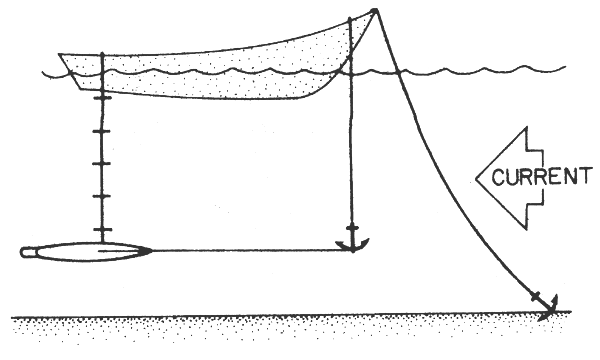
Figure 3.1 Arrangement for sampling semi-buoyant eggs in a stream (after Hass, 1968). The net is suspended by two ropes from a boat anchored in the stream. The ropes are paid out simultaneously to sample at varying distances above the bottom
If turbulence is lacking and all eggs are on the bottom, the “saltwater-egg-sampler” developed by Nissinen (1972) for determining egg numbers in spawning areas of C. albula can be used. In this device the eggs are lifited from the bottom and collected in a net gauze chamber by salt water pumped into the system (Figure 3.2). Eggs of Coregonus lavaretus have been collected by a SCUBA diver with a pipette (Bagenal, unpublished) from a sandy bottom, and this method could be made quantitative.
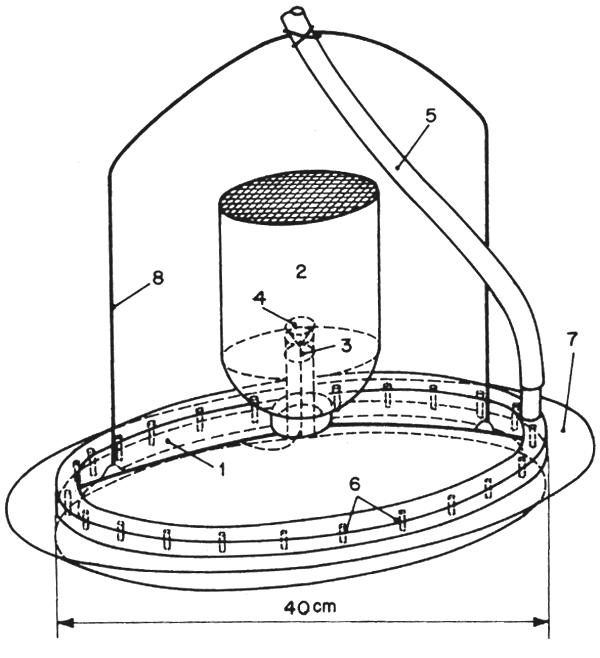
Figure 3.2 Salt water sampler (after Nissinen, 1972). The sampler is lowered to the bottom by the handle (8) and the flange (7) prevents it sinking into the sediment. Salt water is pumped down the rubber tube (5) and is distributed within the sampler through a ring of jets (6). The eggs float on the denser salt water and are lifted off the bottom into the funnel (1), up the tube (3), through the valve (4) into the collecting chamber (2)
Some eggs are adhesive when they are spawned but become free-floating later, for example the European smelt Osmerus eperlanus (Lillelund, 1961). The eggs of a few species are laid in foam nests made by the adults and float at the water surface.
The eggs of the perce Perca fluviatilis are in a large gelatinous sheet. This egg mass is heavier than water and lies on the bottom or more often is entangled in weed or sticks. in these cases the eggs can be sampled with a hand net.
(c) Adhesive eggs
A great many freshwater fish are open sub-stratum spawners (Balon's A.1) that produce adhesive eggs which stick on rock or gravel, weed or sand.
Rocks and gravel:
Quantitative sampling is very difficult since few grabs work effectively on coarse sub-strata, and even in shallow water it is difficult to sample quantitatively, but the device described by McNiel (1964) for salmonid redds might be tried. Dredges may be used for non-quantitative sampling; Gaigher, Ntloko and Visser (1975) dragged a stream bottom sampler over a gravel bottom for a short distance and then sorted the material for the eggs of Labeo umbratus.
Weed:
Adhesive eggs may be collected by cutting the spawning substrate from weed beds, but this technique is very difficult to use quantitatively and counting the eggs on large amounts of weed is very laborious.
Sand:
Attempts at quantitative sampling with a grab might be successful if the deposit is not too compacted. We do not know of any cases where this has been tried.
Artificial substrates:
Sampling units of artificial substrates may be placed throughout the spawning area to provide representative samples of eggs. These substrates may be trays of gravel, sand, artificial weed, rope or tiles. Attempts should be made to simulate the natural substrate as closely as possible. Bagenal and Hewitt (unpublished) have used floating rope as an artificial substrate for roach Rutilus rutilus. Rothschild (1961) used heavy black canvas strips 5 cm wide and about 12.5 cm long as a substrate for smelt Osmerus mordax eggs. The narrow ends of each strip were joined by a rubber band stapled to each end which formed a collar-like arrangement that permitted each strip to be slipped easily on and off a ceramic tile 11.5 cm square. The eggs on one side of a unit were counted each morning. The second surface remained so that the eggs accumulated. The temporary surface gave data on egg production and the permanent one gave data on egg mortality. The estimate of egg production followed methods of representative but disproportional sampling (Schumacher and Chapman, 1954).
(d)Hidden eggs
This section contains those eggs which are hidden in a redd, nest or elsewhere and then abandoned by the parents. It may be necessary to find from the literature or tank experiments where the eggs should be looked for.
Salmonids and grayling Thymallus spp. make redds, which are excavated hollows in gravel in which the eggs are shed and fertilized and then covered with more grave. Some salmonid redds are easily identifiable from the colour of the newly turned stones and can be counted within a certain section of the river. The average number of eggs per redd may be obtained by digging; the relatively light eggs are collected in a net suitably arranged in the current down stream (Briggs, 1953). A more elaborate and efficient method is to use the sampler designed by McNiel (1964). Trout eggs naturally washed from the gravel were caught in drift nets by Elliott (1976). Redds are also made by lampreys and may be sampled in a similar manner.
The bitterling Rhodeus sericeus and a few other species deposit their eggs in the gill chambers of live freshwater mussels Unio and Anodonta. Sampling the mussels quantitatively is difficult, but a grab might be tried since bitterling typically inhabit areas with a soft muddy bottom.
A few freshwater fish lay eggs which are attached to rocks or weeds and are guarded by the male (Balon's B.1), for example Silurus glanis, Polypterus and Stizostedion lucioperca.
However, most guarders are also nest builders (Balon's B.2) and the nests are usually clearly visible. It is important to know where the nests are likely to be; for example the three-spined stickleback Gasterosteus aculeatus constructs a nest on the bottom, whereas the ten-spined stickleback Pungitius pungitius makes a nest in weed off the bottom. Quantitative sampling of such nests may be difficult, but each nest is usually guarded by the male who is territorial, and each nest may contain eggs from a number of females. Neves (1975) describes the nests of the small-mouth bass Micropterus dolomieu which are scooped out of coarse gravel. The mean water depth of several nests was 84 cm and he sampled one rock with its adhesive eggs by using a “kitchen baster”. Small larvae were sampled in the same way. Each nest was guarded by a male and the removal of the male led to total egg mortality.
Nests are not always easily visible but may be under stones, for example the sculpin Gottus gobio. In places where the water is shallow, nests can be found by wading, picking up likely stones. Elsewhere, SCUBA diving may be needed.
More exotic nest sites are given by Balon (1975) and Breder and Rosen (1966).
Many species, especially members of the Cichlidae, carry their eggs and larvae in the mouth (and elsewhere). In these cases, and with viviparous species, the eggs may be sampled by catching the parents with usual fishing methods, but the possibility of egg loss before the adult is examined must be carefully considered. Storing the fish individually in polythene bags immediately after they were caught with a seine net was found to be effective for the mouthbrooding Sarotherodon leucostictus (Welcome, 1967).
Most freshwater fish larvae have some swimming ability. They are considerably more difficult to sample quantitatively than are fish eggs, unless they occur in open water as marine fish larvae usually do. But few freshwater fish species have planktonic and pelagic larvae. In several species, for example pike (Esox Lucius) and many cyprinids, the young have an adhesive organ on the head and while the yolk-sac is being absorbed, they attach themselves to plants. However, if the plants are disturbed, for instance by a sampling device, they are able to move to another site and so avoid capture. When the yolk is almost absorbed, they are able to maintain their position near the shore and rarely occur in open water. The larvae of many species inhabit very small bays, hollows and back-waters at the edges of ponds, rivers and lakes and are often in water only a few centimetres deep. Here they are very difficult to catch. It is therefore important that the behaviour of the larvae should be considered in relation to their distribution and their catchability.
Nellen and Schnack (1975) give examples of how the distribution of larvae in a particular location influences the species composition of the catch. In the Schlei, a brackish water fjord 40 km long near Schleswig, Nellen (1965) towed a 1 m diameter net at 2 knots (3.7 km/h) below the surface and obtained good catches of 18–42 mm smelt and 8–11 mm perch in May and June but no cyprinid larvae. In push net catches in the littoral among reeds, cyprinid larvae were caught, as well as smelt and perch larvae. Similar observations were made in the Kiel canal.
Link (1973) sampled fish larvae in the River Eider, which limnologically is a lake some 80 km long and 250 m wide, rather than a river. He sampled one section with a doule neuston net in the second half of May and in June close to each bank and in the middle at five different stations. The operation was designed to investigate the effects of a cross wind on the distribution of plankton, but only the results for fish larvae will be reported here. Percid larvae were most abundant by the up-wind shore. The ratios of numbers on this side of the river to numbers on the down-wind side were 12 to 0 in the upper net and 118 to 16 in the lower net. In the middle of the channel 27 percid larvae were caught and they were all in the lower net. Smelt larvae were also mainly caught in the lower net, but showed no distribution that could be associated with the wind. Larval cyprinids were absent from the mid-channel catches and in the upper net the ratio of up-wind to down-wind catches was 34 to 52 and in the lower net 25 to 17.
Larval perch move from the shore to open water soon after hatching where they can be caught in high-speed tow nets (Noble, 1970). This movement may be partly passive transport in surface currents because the larvae are said to be free-floating due to a large oil globule in the yolk-sac (Schneider, 1922). However, they soon move back to the shore and form free-swimming shoals, even when as small as 8mm in length. Noble (1970) found that at this size they could avoid plankton nets.
Pike-perch Stizostedion lucioperca larvae are said to stay close to the spawning grounds at a depth of 2 to 4 m and move to prey on 0-group perch in the autumn (Schneider, 1922), but Houde and Forney (1970) show that the larvae of walleyes Stizostedion vitreum drift into the main body of the lake in wind-generated currents. Larvae of 9.5 mm length have a sustainable swimming speed of 3.0 cm/sec (Houde, 1969) and open water currents almost always have a greater velocity.
Pike Esox lucius usually spawn in shallow areas and small back-waters. The larvae soon take up a solitary life in wait of prey in habitats near the shore (Schindler, 1934) so they may not be expected to be pelagic at any time in their life history.
It is obvious from this discussion that young freshwater fish larvae in contrast to plankton (D'Ancona, 1955; Colebrook, 1960; Langford and Jermolajev, 1966) are not greatly affected by wind or currents, that is they are not truly planktonic, but are able to show definite habitat preferences at a very early age.
The examples of larval habitat selection given above suggest that methods copied directly from marine investigations, which sample larvae from the plankton, will not often be successful in fresh water. However, well-tried marine methods may be recommended whenever they appear to be appropriate. For example, this might be the case in a programme of sampling coregonid larvae which can be expected to in habit the epipelagic zone, as do the adults. However, some marine larval sampling methods depend on the availability of powerful research vessels with derrick and winch facilities, for example to handle a Gulf III sampler (Figure 3.3) or a Bongo net (Figure 3.4).
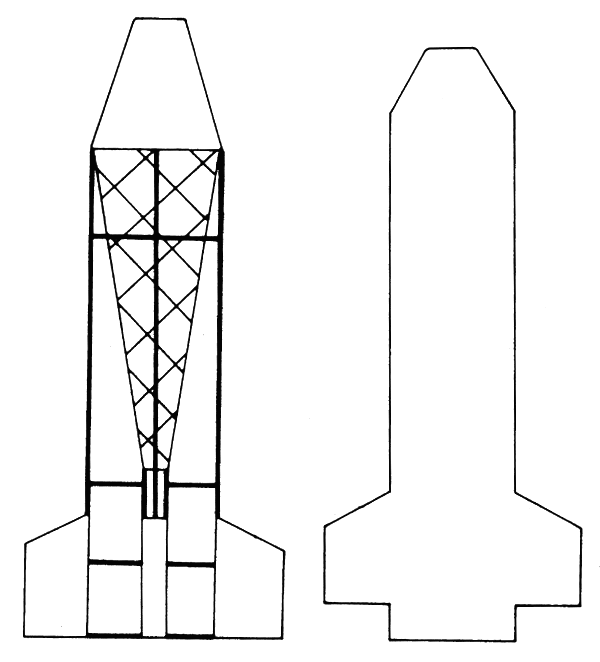
Figure 3.3 Encased (above) and unencased type of Gulf III sampler seen from above. The nose-cone (left end) restricts the amount of water entering the sampler. The water passes through the net (cross hatched) and leaves at the rear end (right) which has two horizontal and one vertical tail fins. Unencased samplers (lower) seem to become clogged less quickly than those encased in a tube (above). The towing attachment is on the upper surface and a position for shackling a depressor is on the lower surface
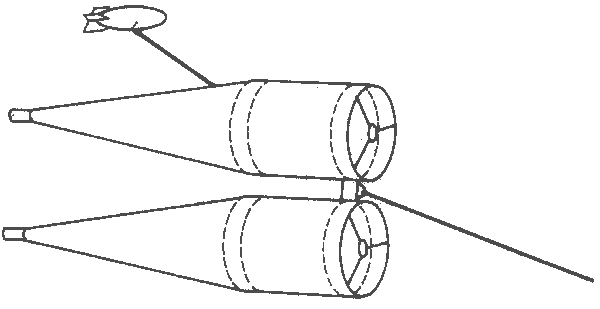
Figure 3.4 Bongo nets consisting of a pair of nets mounted horizontally, each with a flow meter suspended in the mouth and towed with a depressor slung beneath
(a) Townets
Simple townets such as are used for zooplankton sampling have often been used to catch freshwater fish larvae in horizontal tows (Hoagman, 1973). In cases where larvae aggregate close to the surface the sampling method described by Miller (1973) who used a shallow-draft catamaran as gear carrying system (Figure 3.5) may be very practicable.
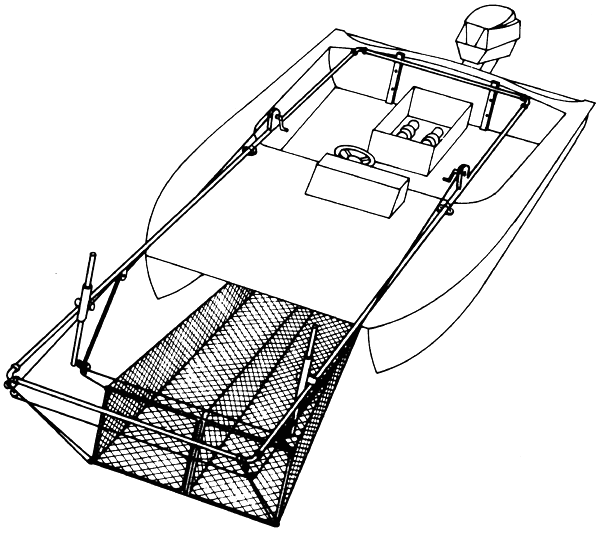
Figure 3.5 A surface larval sampling device (after Miller, 1973). The net is mounted on the front of a shallow draft catamaran with arrangements so that the catch may be extracted through well in the centre of the boat and the mouth of the net may be controlled from within the boat. (For details see Miller, 1973)
Amundrud, Faber and Keast (1974) mounted twin conical nets at the ends of a 3.05 m frame across the bow of a boat. The nets were 61 cm in diameter and 2.5 m long with a 2 litre bucket. They were towed at 38.5 m/min (2.3 km/hr) for 2 minutes to catch free-swimming perciform larvae in Lake Opinicon, Ontario.
Simple zooplankton nets have been developed by marine biologists into the Hansen Egg Net and the Helgoland Larvae Net (Figure 3.6) which are both used for vertical hauls from a given depth to the surface, but we do not know of any instance of their use in fresh waters.
| Figure 3.6 |  |
| Helgoland larval net. A heavy duty net used by marine biologists for vertical quantitative hauls. The entrance is restricted by a canvas inverted truncated cone. The weight of the collecting bucket is taken by vertical cords which are slightly shorter than the net |
A 1 m diameter townet, the CalCoFi net, which has been developed for a marine fish egg and larvae survey (Ahlstrom, 1954) has been made suitable for its use in lakes (Johnson, 1956). This heavy gear can be towed by means of two boats powered with outboatd motors (15 to 25 horse-power), the boats running parallel about 30 m apart. Nothing precedes the mouth of the net while fishing (Figure 3.7). For surface tows, each boat was equipped with a 30 m tow line of 6 mm nylon rope. In order to fish at greater depths, it is necessary to attach a depressor to the two lines. This requires greater towing power, longer two lines and winches for handling the net. However, experience has shown a greater fishing success with surface tows for young sockeye salmon Oncorhynchus nerka. Also catches increase rapidly at dusk and then fall again, so that at night they are rare (Johnson, 1956).

Figure 3.7 A townet for sampling from two boats (after Johnson, 1956). The two towing ropes diverse so that nothing precedes the mouth of the net in which is mounted a flow meter
As fish larvae surveys in the marine environment showed larvae avoided slow moving nets, various devices were made which could be towed at up to 14 km/h
The Miller High Speed Sampler (Miller, 1961) has been tried and evaluated by Noble (1970). This is a smaller version of the Gulf III sampler. In the latter, a mouth cone reduce the mouth opening from 45 cm to 20 cm. The net is encased in a metal (or glass-reinforced plastic) pipe, through the virtue of an encasement is doubtful (Nellen and Hemple, 1969). The sampler is suspended so that, the bridle is not in front of the opening and a depressor is attached beneath it. The towing speed is 4 to 6 knots (7.4 to 11.1 km/h). The Gulf III has been tried at 8 km/h for catching perch larvae (Bagenal, unpublished) but these fish soon move to shallows water the sampler cannot be used.
The Miller sampler used by Noble (1970) had a mouth opening of 10cm. He used it in a larval surey of the walleys, Stizostedion vitreum and yellow perch perca flavescens. Because of its smaller size, it could be operated from a small boat powered by an outboard motor.
| Figure 3.8 | 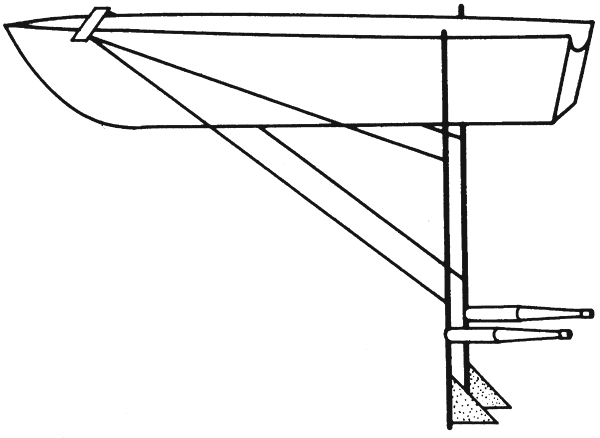 |
| A double pole device for evaluating the Miller high- speed sampler (after Noble, 1970). The two samples are mounted on two poles based in a vertical position and fitted with stabilizing vanes |
In order to test its efficiency, Noble (1970) designed special equipment to maintain an accurate depth. Two aluminium pipes were suspended vertically from a hinged clamp on each side of the stern. The two poles reached to a depth of 3m and a sampler was attached 1 m from the bottom of each pole (Figure 3.8). This apparatus was used for several tests which gave the following results:
The fry of yellows perch and walleys could avoid a standard Miller sampler towed at 12.9 km/h during daylight hours. Apparently avoidance begins when fry are less than 8 mm long
Speeds above 12.9 km/h were shown to be effective in increasing catches per volume of water filtered
Comparisons of day and night catches, and catches from translucent and clear samplers compared with those from dark samplers showed that avoidance was a response to a visual stimulus.
Avoidance could be decreased by immobilizing and disorienting he larvae with an electric shocker in front of the sampler. The shocker consisted of two 61 cm diameter grids, 23 cm apart, which were supplied with a current of 220 volts A.C. (Figure 3.9)
A sampler with an aperture 1.5 times the area of the standard one did not appear to be more efficient
Avoidance by yellow perch fry was not eliminated by speeds up to 17.7 km/h and the apparent efficiency at this speed was lower than with an electric shocker and night sampling
With the clear sampler, avoidance was consistently higher at 0.5 m than at 1.5 m. This depth effect of avoidance can be associated with the light intensity which was 25 percent lower at the greater depth
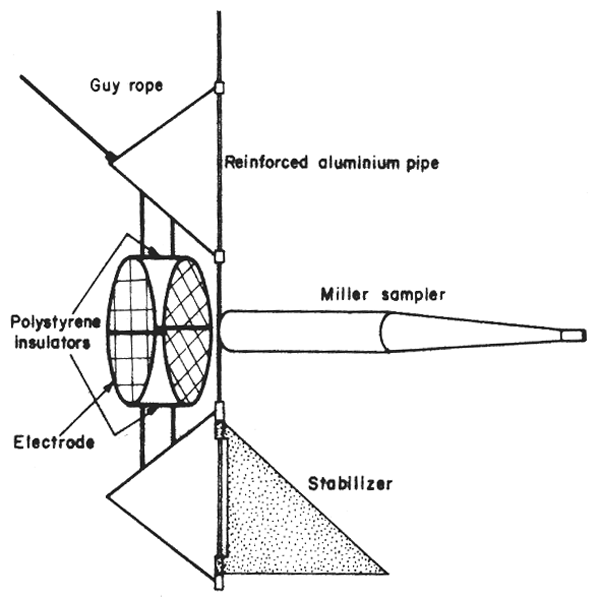
Figure 3.9 Details of electric fry larval shocker mounted in front of a Miller high-speed sampler (after Noble, 1970). The shocker consists of two 61-cm diameter circular hoops 23 cm apart with polystyrene insulators, each supplied with 220 volts A.C.
Forney (1975) gives results of using a Miller High Speed Sampler in Oneida Lake, New York, to catch larval walleyes during their pelagic stage. He maintains that the similarity between estimates from successive surveys in the same year, and the consistency of higher larval populations in years when larvae were stocked, demonstrate the sampler's reliability. In this study the samplers had a 14 cm diameter body (green in early years and unpigmented later) with an orifice of 10 cm. The samplers had 333 u Nitex nets and two samplers were attached to two cables with 7 kg depressors and towed from a boat with twin 40 hp motors. In the same lake, Noble (1972) used a Miller sampler for walleyes with a larger mesh of 760 u monofilament nylon and caught larvae down to 10 mm.
For newly hatched whitefish larvae in South Bay, Lake Huron, Faber (1970) mounted a large townet on a sledge. This proved effective for larvae close to the bottom.
Brown and Langford (1975) have assessed the merits of a sledge-mounted townet for sampling coarse fish fry in flowing water. The gear consisted of light metal framework covered by nylon netting of 4 meshes/cm, with a bag of 8 meshes/cm. Three floats attached to the frame enabled it to be pulled along just below the water surface and two skids allowed it to run on the river bed in shallow water. The net was towed at about 4 km/h, 10 m behind a boat for 40–60 m. The catch from the first tow was always larger than from the second. Seventeen species were caught, roach, bleak and silver bream being the most common. The smallest individual fish was 11 mm long and the smallest mean of more than 20 fish was 14–25 mm. The smallest fish were caught in May and June when one year old fish were also often captured.
(b) Buoyant nets
A different approach to net avoidance was used by Bagenal (1974). Instead of relying on greater speed, he relied on stealth. He noted that roach larvae were less wary of nets approaching from below than from any other direction and that shoals appeared to settle down fairly quickly after a disturbance. He therefore designed a buoyant net that could be kept near the bottom by a retrievable weight, and which could be released when half a polo mint (Life Saver) dissolved in 2–3 hours after being set (Figure 3.10). Tests showed that when the net rose from the bottom it caught all the larvae in the column of water above it quantitatively. By setting ten nets on two days per week in a 1 ha pond, he was able to estimate mortality rates with reasonable precision. These nets have the advantage that they may be used among some kinds of macrophytes, for example among Nuphar.
(c) Traps
Breder (1960) designed a clear plastic trap for larvae and small fish. It consists of a box with two wings which continue inward to form a re-entrant slit. The wings are removable and are held in place by elastic bands which hook onto lugs cemented to the sides of the trap (Figure 3.11). Traps of this kind may be made in various sizes, and the length of the wings may be varied. It can be set on the bottom or suspended in mid-water from a float in mid-water, or among weed.
Burgner (1962) describes a trap for catching red salmon fry in Wood River Lakes, Alaska. Emergent traps for salmonid alevins have been described by Heard (1964) (Figure 3.12), Porter (1973) and Collins (1975).
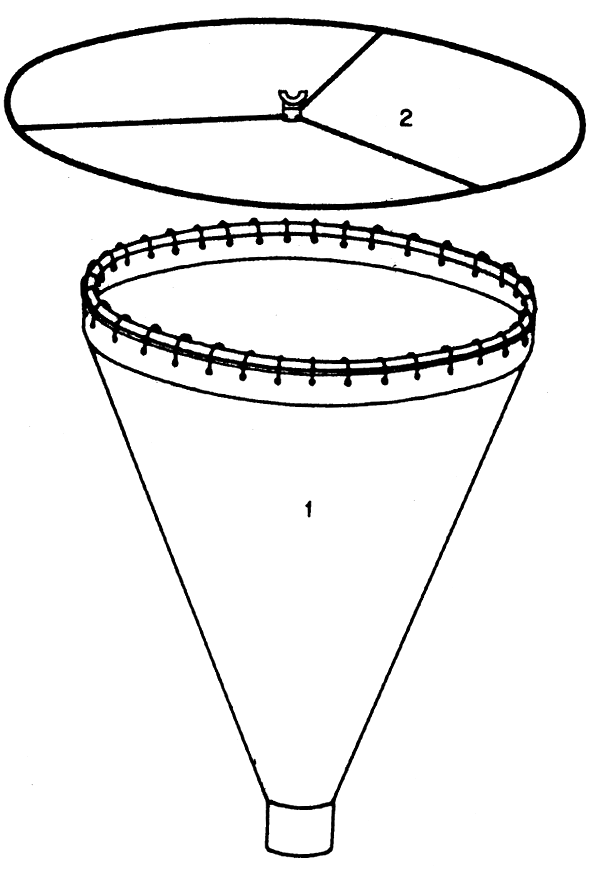
Figure 3.10 Buoyant net (after Bagenal, 1974). The net (1) is fastened to a buoyant ring made of thick plastic water pipe filled with air. The net is sunk on the bottom by 2, which consists of a heavy iron ring with three bridles meeting in a release device in the centre. The release device consists of a plastic ring and a ‘Polo’ mint. When the mint dissolves in approximately 2 hours the bridles become free and the net arises vertically to the surface. The iron ring is buoyed for recovery
| Figure 3.11 A plastic fry trap (after Breder, 1960) which consists of a clear plastic box with two wings which continue inward to form a re-entrant split. The wings are held in position by elastic bands hooked on to lugs cemented to the sides of the trap | 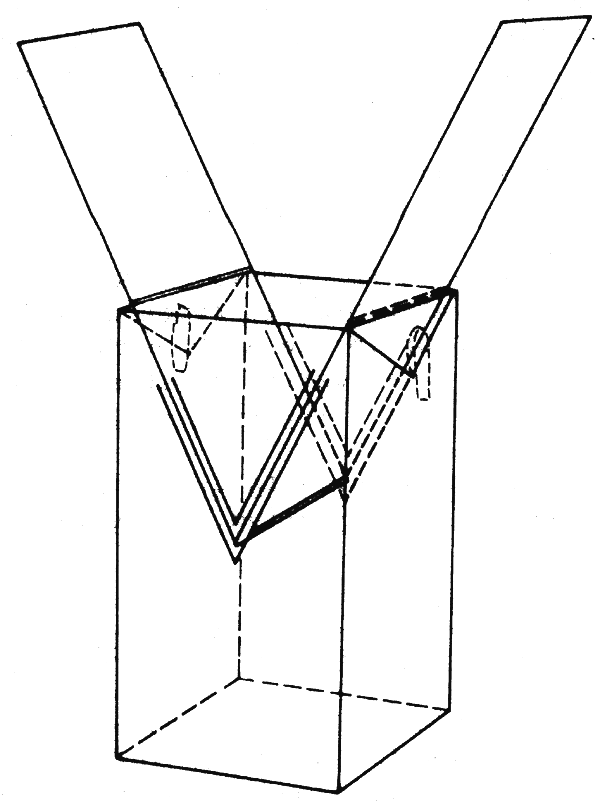 |
| Figure 3.12 A trap for catching emerging salmonid (after Heard, 1964). The trap is pegged on top of a redd and the alevins are carried by the current into a collecting net | 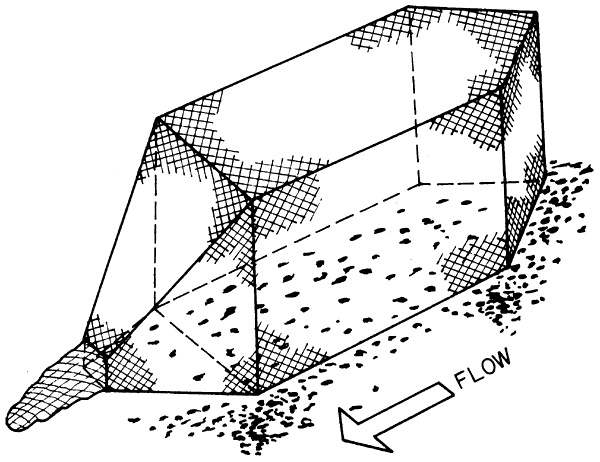 |
The larvae of many fish species are attracted to lights at night. Bagenal (unpublished) caught perch larvae in a make-shift trap of black polythene sheet on an aluminium angle frame and with a light behind a clear non-return flap. He has also caught perch larvae in a buoyant net under a light suspended above the surface. In this case the release device was made of a needle which could be pulled out by a length of cotton to the shore. From the data given by Nagięć (1975), it is clear that lighted traps catch considerably more fish at night than do unlighted ones. In these experiments the light was provided by a torch placed inside the trap which measured 9 cm×70 cm with a 1 mm bar mesh. The mean catch per night of four lighted traps reached 292 perch, 1,390 ruffe (Gymnocephalus cernua), and 26 pike-perch on different occasions.
Stationary nets, used for sampling in flowing water, are also kinds of traps. Several nets have been developed to catch drifting invertebrates in streams, and Elliott (1966) reported young trout in the early night catches. An effective channel net for catching larval fish in channels, estuaries or streams has been constructed by Lewis et al. (1970).
The chief objection to traps is that several - especially those which are used in still water - are not quantitative, and some species are not attracted to light.
(d) Purse Seines (see also Section 6.7)
Nellen and Schnack (1975) suggest that a small mesh purse seine would overcome many of the disadvantages of townets in inland waters. They point out that it is easy to use, requires little, if any, mechanical power and is an efficient fishing method. These authors refer to Murphy and Clutter (1972) who used a plankton purse seine for catching anchovy larvae. The net had a body of 333 μ Nitex, 30 m long and 7 m deep with a small cod end at one end of the net. It requires two men to operate who set it in an incomplete circle which was closed during the first stages of hauling. From setting the net to pursing usually took less than five minutes, and a complete haul took 15 to 20 minutes. The catch had to be carefully washed toward and into the cod end during the later stages of hauling. It was not easy to use, but comparisons with 1 m townet catches shoed that the latter seriously under-estimated the larger larvae.
A shallower purse seine was described by Nagięć (1975) for catching pike-perch fry. This net, which was 27.5 m long; 3.5 m deep, and had a mesh size of about 5 mm, was used at night on the bottom. The results were good except when used on soft mud which made sorting the catch difficult.
Juvenile fish are generally less difficult to sample than are eggs and larvae, and scaled-down gear suitable for adults has often proved satisfactory.
Raymond and Collins (1975) describe a method of shore seining for juvenile chinook salmon Oncorhynchus tshawytscha using a variable mesh seine described by Sims and Johnsen (1974). This net could be used where the bottom was sand, hard mud or gravel and with a current. In deeper water offshore they used large (183 to 279 m long) purse seines and refer to Durkin and Park (1967) and Johnsen and Sims (1973). Shore seines were also successfully used by Mason (1974) for juvenile coho salmon O. kisutch, and Rodgers (1973) for sockeyes.
Raylond and Collins (1975) give details and references of traps for juvenile Pacific chinook salmon and steelhead trout Salmo gairdneri. In creeks and rivers with water flows greater than 1.2 m/s floating self-cleaning traps modified from Humphrey (1969) proved efficient. At lower velocities traps similar to those used by Mason (1966) and Korma and Raleigh (1970) were effective. In impoundments where the velocity was very low, “Merwin”traps similar to those of Hamilton et al. (1970) were used.
Shearer (1975) describes a simple trap consisting of an angled fence with a box at the downstream end to collect Atlantic salmon Salmo salar, smolts and parr. The arrangement of the trap, which sampled only a small proportion of the migrating juveniles, was such that the total population could be estimated by Bailey's (1951) modification of Peterson's method.
In general, small fish are more difficult to catch with electric fishing gear than are larger ones. However, young trout Salmo trutta were caught at less than 2.6 cm in length by McCormack (1962), as well as juveniles.
Voigtlander and Wissing (1974) caught young and yearling white bass Morone chrysops down to 48 mm by electric fishing with 230 V A.C.
Although marine biologists have considerable experience of catching fish eggs and larvae quantitatively, much of it is not relevant to the freshwater environment. Nevertheless, some methods may be adapted and anyone starting to work on the larvae of species of unknown habits would be advised to consult handbooks on marine methods as well as freshwater.
Good accounts of marine methods are given in Simpson (1956), the UNESCO Handbook (UNESCO, 1968) and Hempel (1973).
Several papers describe or report tests on different samplers, for example Posgay and Marak (1967), Bridger (1958), David (1965), Harding, Nichols and Tungate (1969), Hempel and Weikert (1972), Miller (1961 and 1973), Saville and McKay (1970), Sherman and Honey (1968), Beverton and Tungate (1967). Comparative efficiency tests on the Bongo sampler (Figure 3.4), a modified Bongo sampler, the Clarke Bumpus plankton sampler and a version of the Gulf III, which are all high-speed samplers, were reported by Bjorke, Dragesund and Ulltan (1974). Schnack (1974) also discusses the efficiency of different designs of Bongo and Gulf III samplers and lays particular stress on the details of handling the gears. Lockwood (1974) gives details of a Gulf V sampler modified for use from an open boat.
Even though marine fishery biologists have considerably more experience in catching fish eggs and larvae than their freshwater colleagues, they find (Hempel, 1974) that no net can sample all size categories of fish larvae in an entirely non-selective manner.
The accuracy of the results depends on a knowledge of the sampling efficiency of the gear, and this includes not only filtration efficiency, avoidance and extrusion, but also the human element in efficient handling of the gear, which only comes with experience.
For simple plankton nets it is well known that if the ratio of the area of the straining apertures (that is, the sum of all the holes) to the mouth area is not less than 5:1, the initial filtration efficiency (that is, before any clogging or other effects) will approach 100 percent. With encased samplers with a mouth-reducing cone, the position is more complex and depends on the shape of the case (Tranter and Smith, 1968). The literature on these aspects of samplers includes Harding et al. (1969); Smith, Counts and Clutter (1968); Bridger (1958); Saville and Mckay (1970) and Schnack (1974).
Avoidance by marine fish larvae of nets with high filtration efficiency is said to occur only with older, more mobile larvae at low towing speeds (about 3.7 km/h) whereas avoidance does not bias results at high speeds (about 9.3 km/h). Avoidance by yellow perch larvae was found even at speeds of 17.7 km/h (Noble, 1970).
Larval abundance in fresh water usually occurs at time of zooplankton maxima and this may lead to severe clogging, in which case the length of tows must be reduced. In this respect cylinder-cone nets have proved favourable to simple conical nets (Smith et al., 1968) and the unencased Gulf III model (Figures 3.3 and 3.7) seems to be less quickly affected by clogging than the encased version (Schnack, 1974).
To ensure sampling at a constant known depth, an efficient depressor must be used. At very slow speeds a weight may be sufficient but at high speeds a V-fin depressor is commonly used. Currents are unlikely to cause problems in most lakes and in any case the distance covered over the ground is less relevant than to filter a given volume by maintaining a constant speed through the water.
The volume of water filtered must be determined during a tow by means of a calibrated flow-meter mounted in the mouth of the sampler. The filtering capacity of the particular model of sampler and its changes due to clogging effects during a haul can be checked by comparing flow readings inside and outside the sampler (Tranter and Smith, 1968).
The precision of fish larval samples is often difficult to determine without considerable work, and it is dependent on the distribution of the species. In general, the precision may be improved by increasing the number of sampling units and decreasing their size. Nearly all fish larvae are likely to be distributed patchily and the size of the sampling variance will depend on the patch size in relation to the tow length. The patchiness is likely to lead to a correlation between the mean and variance. In this case the analysis should only be performed after a logarithmic or other suitable transformation.
Ahlstrom, E.H., 1954 Distribution and abundance of egg and larval populations of the Pacific sardine. Fish.Bull.U.S.Fish Wildl.Serv., 56:83–140
Amundrud, J.R., D.J. Faber and A. Keast, 1974 Seasonal succession of free-swimming percifora larvae in Lake Opinicon, Ontario. J.Fish.Res.Board Can., 31(10):1661-5
Bagenal, T.B., 1974 A buoyant net designed to catch freshwater fish larvae quantitatively. Freshwat. Biol., 4:107-9
Bailey, N.T.J., 1951 On estimating the size of nobile populations from recapture data. Biometrika, 38:293–306
Balon, E.K., 1975 Reproductive guilds of fishes: A proposal and definition. J.Fish.Res.Board Can., 32(6):821-64
Balon, 1975a Terminology of intervals in fish development. J.Fish.Res.Board Can., 32(9): 1663-70
Battle, H.I. and W.M. Sprules, 1960 A description of the semi-buoyant eggs and early development stages of the goldeye Hiodon alasoides (Rafinesque). J.Fish.Res.Board Can., 17, 245-66
Beverton, R.J.H. and D.S. Tungate, 1967 A multi-purpose plankton sampler. J.Cons.CIEM, 31:145-57
Bjørke, H., O. Dragesund and ø. Ulltang, 1974 Efficiency tests on four high-speed plankton samplers. In The early life history of fish, edited by J.H.S. Blaxter, Berlin, Springer Verlag, pp. 183–200
Breder, C.M., 1960 Design for a fry trap. Zoologica, N.Y., 45:;55-9
Breder, C.M. and D.E. Rosen, 1966 Modes of reproduction in fish. New York, Garden City, Natural History Press, 941 p.
Bridger, J.P., 1958 On efficiency tests made with a modified Gulf III high-speed townet. J. Cons. CIEM, 23:357-65
Briggs, J.C., 1953 The behaviour and reproduction of salmonid fishes in a small coastal stream. Fish Bull.Calif., (94):62 p.
Brown, D.J.A. and T.E. Langford, 1975 An assessment of a townet used to sample coarse fish fry in rivers. J. Fish Biol., 7:533-8
Burgner, R.L., 1962 Sampling red salmon fry by lake trap in the Wood River Lakes, Alaska. Univ.Wash.Publ.Fish., (1):315-48 (Abstr.)
Colebrook, J.H., 1960 Plankton and water movements in Windermere. J.Anim.Ecol., 29:217-40
Collins, J.J., 1975 An emergent fry trap for lake spawning salmonines and coregonines. Prog. Fish-Cult., 37:140-2
D'Ancona, U., 1955 The stability of lake plankton communities. Verh.Int.Ver.Theor.Angew.Limnol., 12:31–47
David, P.M., 1965 The neuston net - a device for sampling the surface fauna of the ocean. J. Mar.Biol.Assoc. U.K., 45:313-20
Davis, C.C., 1959 A planktonic fish egg from fresh water. Limnol.Oceanogr., 4:352-5
Durkin, J.T. and D.L. Park, 1967 A purse seine for sampling juvenile salmonides. Prog.Fish-Cult., 29:56-9
Elliott, J.M., 1966 Downstream movements of trout fry (Salmo trutta) in a Dartmoor stream. J. Fish.Res.Board Can., 23(1):157-9
Elliott, J.M., 1976 The downstream drifting of eggs of brown trout, Salmo trutta L. J.Fish Biol., 9:45–50
Faber, D.J., 1970 Ecological observations on newly hatched lake whitefish in South Bay, Lake Huron. Winnipeg, Biology of Coregonid fishes, edited by C.C. Lindsay and C.S. Woods. University of Manitoba Press, pp. 481–500
Forney, J.L., 1975 Abundance of larval walleyes (Stizostedion vitreum) estimated from the catch in high-speed nets. EIFAC Tech.Pap., (23) Suppl.1,vol.2:581-8
Gaigher, I.G., M.M. Ntloko and T.G. Visser, 1975 Reproduction and larval development of Labeo umbratus (Pisces, Cyprinidae) in the Tyume River, Eastern Cape. J.Limnol.Soc. S.Afr., 1:7–10
Hamilton, J.A.R. 1970 et al., Use of a hydroelectric reservoir for the rearing of coho salmon, (Oncorhynchus kisutch). Res.Bull.Dep.Fish Wash., (9):65
Harding, D., J.M. Nichols and D.S. Tungate, 1969 Comparative tests with high speed plankton samplers. ICES CM. 1969 L:19
Hass, H., 1968 Untersuchungen über die vertikale und horizontale Verteilung der Eier der Finte, Alosa fallax (Lacépède, 1803) in der Elbe. Arch.Fischereuwiss., 19:46–55
Heard, W.R., 1964 Phototactic behaviour of emerging sockeye salmon fry. Anim.Behav., 12:382-8
Hempel, G., 1973 Fish egg and larval surveys. FAO Fish.Tech. Pap., (122):82 p.
Hempel, 1974 Summing-up of the symposium on the early life history of fish. In the early life history of fish, edited by J.H.S. Blaxter, Berlin. Springer Verlag, pp. 755-9
Hempel, G. and H. Weikert, 1972 The neuston of the subtropical and boreal Northeastern Atlantic Ocean: a review. Mar.Biol., 13:70–88
Hoagman, W.J., 1973 The hatching, distribution, abundance, growth and food of the larval white-fish (Coreagonus clupaeformis, Mitchell) of central Green Bay, Michigan. Rep. Inst.Freshwat.Res.Drottningholm, (53):20 p.
Hopson, A.J., 1970 A study of the Nile perch (Lates niloticus (L.), Pices: Centropomidae) in Lake Chad. Overseas Res.Publ.,G.B., (19):93 p.
Houde, E.D., 1969 Distribution of larval walleyes and yellow perch in a bay of Oneida Lake and its relation to water currents and zooplankton. N.Y.Fish.Game J., 16:184–205
Houde, E.D. and J.L. Forney, 1970 Effects of water currents in distribution of walleye larvae in Oneida Lake, New York. J.Fish.Res.Board Can., 27(3):445-56
Humphrey, W.R., 1969 Self-cleaning downstream migrant trap. LaGrande, Oregon. Oregon State Game Commission (unpubl.Rep.), 12 p.
Johnsen, R.C. and C.W. Sims, 1973 Purse seining for juvenile salmon and trout in the Columbia River estuary. Trans.Am.Fish.Soc., 102:34-5
Johnson, W.E., 1956 On the distribution of young sockeye salmon (Oncorhynchus nerka) in Babine and Nilkitkwa Lakes, B.C. J.Fish Res.Board Can., 13(5):695–708
Korma, R.F. and R.F. Raleigh, 1970 Migration of juvenile salmon and trout into Brownlee Reservoir, 1962-65. Fish.Bull.NOAA/NMFS, 68:203-12
Kryzhanovsky, S.G., 1949 Eco-morphological principles of development among carps, loaches and catfishes. Part 2. Ecological groups of fishes and patterns of their distribution. Tr.Inst.Morphol.Zhivotn., 1:237-33. (in Russian). Issued also as Transl.Fish.Res.Board Can., (2947) (1974)
Langford, R.R. and E.G. Jarmolajev, 1966 Direct effect of wind on plankton distribution Verh.Int.Ver.Theor.Angew.Limnol., 16:188-93
Lewis, R.M. 1970 et al., A channel net for catching larval fish. Chesapeake Sci., 11:196-7
Lillelund, K., 1961 Untersuchungen über die Biologie und Populationsdynamik des Stintes Osmerus eperlanus eperlanus (Linnaeus, 1958), der Elbe. Arch.Fischereuwiss., 12(Suppl. 1):128 p.
Link, G., 1973 Untersuchungen über Chemismus und Zooplankton der Untareider. Dissertation, Kiel. 150 p.
Lockwood, S.J., 1974 The use of a modified Gulf V sampler from a small open boat. J.Cons.CIEM, 35:171-4
Mason, J.C., 1974 Aspects of the ecology of juvenile coho salmon (Oncorhynchus kisutch) in Great Central Lake, B.C. Tech.Rep.Fish.Res.Board Can., (438):37 p.
Mason, J.E., 1966 The migrant dipper: a trap for downstream migrating fish. Progr.Fish Cult., 28:96–102
McCormack, J.C., 1962 The food of young trout (Salmo trutta) in two different backs. J.Anim. Ecol., 31:305-16
McNiel, W.J., 1964 A method of measuring mortality of pink salmon eggs and larvae. Fish.Bull. U.S.Fish Wildl.Serv., 63(3): 575-88
Miller, D., 1961 A modification of the small Hardy plankton sampler for simultaneous high-speed plankton hauls. Bull.Mar.Ecol., 5:165-72
Miller, J.M., 1973 A quantitative push-net system for transect studies of larval fish and macrozooplankton. Limnol.Oceanogr., 18:175-8
Murphy, G.I. and R.I. Clutter, 1972 Sampling anchovy larvae with a plankton purse seine. Fish. Bull.NOAA/NMFS, 70:789-98
Nagięć, M., 1975 Description of a ring net and a trap net for the sampling of pike-perch fry. EIFAC Tech.Pap., (23) Suppl.1,vol.2:565-70
Nellen, W., 1965 Beitràge zur Brachwasserökologie der Fische in Ostsesraum. Kiel.Meeresforsch., 21:192-8
Nellen, W. and G. Hempel, 1969 Versuche zur Fängigkeit des “Hai” und des modifizierten Gulf V Plankton Samplers “Nackthai”. Ber.Dtsch.Wiss.Komm.Meeresforsch., 20:141-5
Nellen, W. and D. Schnack, 1975 Sampling problems and methods of fish eggs and larvae investigations with special reference to inland waters. EIFAC Tech.Pap., (23) Suppl.1, vol.2:538-51
Neves, R.J., 1975 Factors affecting fry production of small mouth bass (Micropterus dolomieui) in South Branch Lake, Maine. Trans.Am.Fish.Soc., 104:83-7
Nissinen, T., 1972 The egg density and the survival of eggs on the spawning grounds of the vendace (Coregonus albula,L.) in the lakes Puruvesi and Oulujarvi. Tiedonantoja, (1) :114 p. (in Finnish)
Noble, R.L., 1970 Evaluation of the Miller high-speed sampler for sampling yellow perch and walleye fry. J.Fish.Res.Board Can., 27 (6) : 1033–44
Noble, R.L., 1972 Mortality rates of walleye fry in a bay of Oneida Lake, New York. Trans.Am. Fish.Soc., 101:720-3
Porter, T.R., 1973 Fry emergence trap and holding box. Prog.Fish Cult., 35:104-9
Posgay, J.A. and R. Marak, 1967 Tests of zooplankton samplers. ICNAF Res.Doc., (67/110)Ser.No. 1910
Raymond, H.L. and G.B. Collins, 1975 Techniques for appraisal of migrating juvenile anadromous fish populations on the Columbia River basin. EIFAC Tech.Pap., (23) Suppl. 1, vol.2:562-65
Rodgers, D.E., 1973 Abundance and size of juvenile sockeye salmon Oncorhynchus nerka and associated species in Lake Aleknagik, Alaska, in relation to their environment. Fish.Bull.NOAA/NMFS, 71:1061–75
Rothschild, B.J., 1961 Production and survival of eggs of the American smelt, Osmerus mordax (Mitchill), in Maine. Trans.Am.Fish.Soc., 90:42-7
Saville, A. and D.W. Mckay, 1970 Tests of the efficiency of various high-speed samplers for catching herring larvae. ICES, Doc.CM 1970/M:7
Schaperclaus, W., 1963 Neus Moglichkeiten zur Ertragssteigerund der Binnenfischeris durch Pflanzen fressende Fische aus China. Dtsch.Fischereiztg., 10:227-40
Schindler, O., 1934 Über die Brut von vier einheimischen Süsswasserfischen (Äsche, Hecht, Flussbarsch und Karpfen). Allg.Fischereiztg., 1934(20)
Schnack, D., 1974 On the reliability of methods for quantitative surveys of fish larvae. In The early life history of fish, edited by J.H.S. Blaxter, Berlin, Springer Verlag, pp.201-12
Schneider, G., 1922 Zur Biologie der ostbaltischen Perciden. Verh.Int.Ver.Theor.Angew.Limnol., 1:58–74
Schumacher, F.X. and R.A. Chapman, 1954 Sampling methods in forestry and range management. Bull.Duke Univ.Sch.For., 7(Rev.) :222 p.
Shearer, W.M., 1975 The estimation of juvenile salmon (Salmo salar, L.) populations in the North Esk, Scotland. EIFAC Tech.Pap., (23)Suppl.1,vol.2:571-80
Sherman, K. and K.A. Honey, 1968 Observations on the catching efficiencies of two zooplankton samplers. ICNAF Redbook, 9168 (3):75–80
Simpson, A.C., 1956 The pelagic phase. In Sea fisheries: their investigation in the United Kingdom, edited by M. Graham, London, Arnold, pp.207-50
Sims, C.W. and R.C. Johnson, 1974 Variable-mesh beach seine for sampling juvenile salmon in Columbia River estuary. Mar.Fish.Rev., 36:23-6
Smith, P.E., R.C. Counts and R.T. Clutter, 1968 Changes in filtration efficiency of plankton nets due to clogging under tow. J.Cons.CIEM, 32:232-48
Tranter, D.G. and P.E. Smith, Filtration performance. Unesco Monogr.Oceanogr.Methodol., (2):27–56
Unesco, 1968 Zooplankton sampling. Unesco Monogr.oceanogr.Methodol., (2):174 p.
Volgtlander, C.W. and T.E. Wissing, 1974 Food habits of young and yearling white bass, Morone chrysops (Rafinesque), in Lake Mendota, Wisconsin. Trans.Am.Fish.Soc., 103: 25–37
Welcomme, R.L., 1967 The relationship between fecundity and fertility in the mouthbrooding ci-child fish Tilapia leucosticta. J.Zool.,Lond., 151:453-68